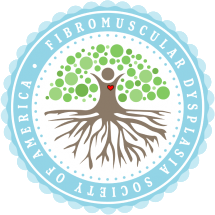First International Consensus on the diagnosis and management of fibromuscular dysplasia
Heather L Gornik (Co-Chair), Alexandre Persu (Co-Chair), David Adlam, Lucas S Aparicio, Michel Azizi, Marion Boulanger, Rosa Maria Bruno, Peter de Leeuw, Natalia Fendrikova-Mahlay, James Froehlich, Santhi K Ganesh, Bruce H Gray, Cathlin Jamison, Andrzej Januszewicz, Xavier Jeunemaitre, Daniella Kadian-Dodov, Esther SH Kim, Jason C Kovacic, Pamela Mace, Alberto Morganti, Aditya Sharma, Andrew M Southerland, Emmanuel Touzé, Patricia van der Niepen, Jiguang Wang, Ido Weinberg, Scott Wilson, Jeffrey W Olin and Pierre-Francois Plouin on behalf of the Working Group ‘Hypertension and the Kidney’ of the European Society of Hypertension (ESH) and the Society for Vascular Medicine (SVM)
Vascular Medicine. January 16, 2019.
DOI: 10.1177/1358863X18821816
This article is a comprehensive document on the diagnosis and management of fibromuscular dysplasia (FMD), which was commissioned by the working group ‘Hypertension and the Kidney’ of the European Society of Hypertension (ESH) and the Society for Vascular Medicine (SVM). This document updates previous consensus documents/scientific statements on FMD published in 2014 with full harmonization of the position of European and US experts. In addition to practical consensus-based clinical recommendations, including a consensus protocol for catheter-based angiography and percutaneous angioplasty for renal FMD, the document also includes the first analysis of the European/International FMD Registry and provides updated data from the US Registry for FMD. Finally, it provides insights on ongoing research programs and proposes future research directions for understanding this multifaceted arterial disease.


 Since ancient times and across many cultures, the tree has long been a symbol of many things, including wisdom, protection, strength, inter-connectivity, and life itself. We’ve chosen the tree to represent the Fibromuscular Dysplasia Society of America for these reasons, and because the tree’s branches and roots signify the arteries affected by this disease. The tree’s branches, reaching upward and outward, provide protection and shelter, and represent our mission to help those who’ve been diagnosed with FMD. Trees, strengthened by their continuously spreading roots, symbolize how as we grow together we are stronger and more resilient. As with its growth from a delicate sapling to a giant robust tree, and as its branches and roots grow and spread, the tree symbol represents how we’ve evolved and continue to promote research, education and patient support throughout the years. Together we can achieve much, as we strive to reach for the sky.
Since ancient times and across many cultures, the tree has long been a symbol of many things, including wisdom, protection, strength, inter-connectivity, and life itself. We’ve chosen the tree to represent the Fibromuscular Dysplasia Society of America for these reasons, and because the tree’s branches and roots signify the arteries affected by this disease. The tree’s branches, reaching upward and outward, provide protection and shelter, and represent our mission to help those who’ve been diagnosed with FMD. Trees, strengthened by their continuously spreading roots, symbolize how as we grow together we are stronger and more resilient. As with its growth from a delicate sapling to a giant robust tree, and as its branches and roots grow and spread, the tree symbol represents how we’ve evolved and continue to promote research, education and patient support throughout the years. Together we can achieve much, as we strive to reach for the sky.